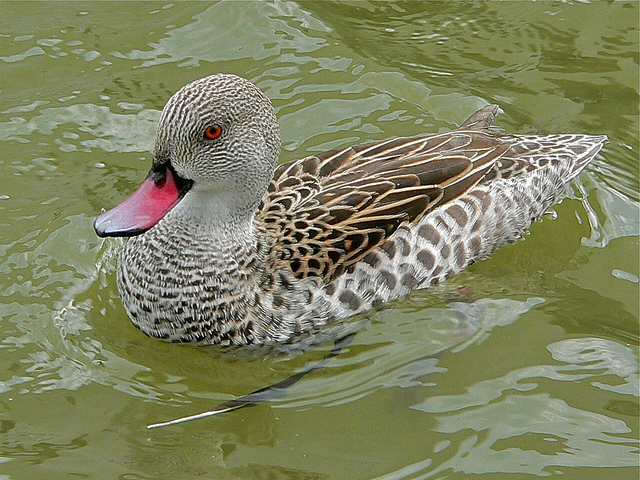
Cape teal(Anas capensis)
Phylum —chordata
Class — aves
Order — anseriformes
Family — anatidae
Genus –anas
Appearance
The Cape teal is a 44–46 cm long dabbling duck. Like many southern ducks, the sexes are similar. It is very pale and mainly grey, with a browner back and pink on the bill (young birds lack the pink). The Cape teal cannot be confused with any other duck in its range.
Habitat
The Cape teal found mostly in and around South Africa, where it is uncommon to locally abundant, being especially populous in the Western Cape, North-West Province and Free State Province.
Behavior
This species is essentially non-migratory, although it moves opportunistically with the rains.
This is a generally quiet species, except during mating displays.
Diet
This species feeds on aquatic plants and small creatures: invertebrates, crustaceans and amphibians.
Reproduction
It is monogamous species. The female builds the nest, which is a 10-16 cm wide bowl, 6 cm deep. It is usually made of aquatic plant leaves and stems, lined with down and contour feathers, usually placed on reed-filled islands.
Laying dates are extremely variable, as Cape teals are opportunistic breeders, only starting after heavy rains.
Female lays 4-13 eggs, in successive mornings.
Incubation is done solely by the female, for 26-30 days. She will sometimes leave the nest for 1-2 hours to bathe and preen, leaving the eggs untended.
The chicks, once dry, are immediately led by their mother to the water, as they know how to dive and swim by instinct. The mother protects them from hostile attacks, by making alarm calls, and pretending to be injured while the ducklings dash for cover. They remain with their mother for about 56 days, after which they start to become independent.
In captivity
Lifespan in captivity is up to 30 years.
In summer, Cape tealsare kept in outdoor enclosures. The minimum size of the enclosure is 4 square meters.
In winter, they should be transferred to an insulated enclosure with a temperature of at least +15 °C. It is desirable to equip the enclosure with additives in the form of branches and perches. In the winter room, you must install a pool with running or frequently replaced water.
As a winter bedding for waterfowl, you can use soft hay, which is laid out in places where birds rest.
The diet includes a mixture of plant and animal feeds. From vegetable feeds give: grain feed - corn, wheat, barley, millet, oatmeal, wheat bran, grass. To these feeds you should add meat and fish meal, chalk, small shell, gammarus. In the warm season, it is good to give various greens - cut dandelion leaves, lettuce, plantain, duckweed. Good food for ducks - wet mixture of grated carrots, bran, various cereals. Fish and minced meat is also suitable. During working out a diet it should be calculated that the amount of raw protein does not exceed 30%.
Cape teals are friendly to other birds, so they can be kept on the same pond with other ducks.
Artificial shelters for nests are installed in the paddock. Ducks independently incubate, breed and raise ducklings.
 Russian
Russian
 English
English























